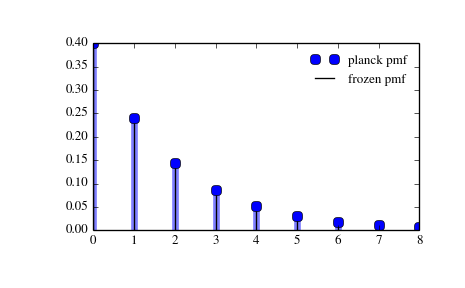scipy.stats.planck¶
- scipy.stats.planck = <scipy.stats._discrete_distns.planck_gen object at 0x7f6169c4c290>[source]¶
A Planck discrete exponential random variable.
Discrete random variables are defined from a standard form and may require some shape parameters to complete its specification. Any optional keyword parameters can be passed to the methods of the RV object as given below:
Parameters: x : array_like
quantiles
q : array_like
lower or upper tail probability
lambda_ : array_like
shape parameters
loc : array_like, optional
location parameter (default=0)
size : int or tuple of ints, optional
shape of random variates (default computed from input arguments )
moments : str, optional
composed of letters [‘mvsk’] specifying which moments to compute where ‘m’ = mean, ‘v’ = variance, ‘s’ = (Fisher’s) skew and ‘k’ = (Fisher’s) kurtosis. Default is ‘mv’.
Alternatively, the object may be called (as a function) to fix the shape and
location parameters returning a “frozen” discrete RV object:
rv = planck(lambda_, loc=0)
- Frozen RV object with the same methods but holding the given shape and location fixed.
Notes
The probability mass function for planck is:
planck.pmf(k) = (1-exp(-lambda_))*exp(-lambda_*k)
for k*lambda_ >= 0.
planck takes lambda_ as shape parameter.
Examples
>>> from scipy.stats import planck >>> import matplotlib.pyplot as plt >>> fig, ax = plt.subplots(1, 1)
Calculate a few first moments:
>>> lambda_ = 0.51 >>> mean, var, skew, kurt = planck.stats(lambda_, moments='mvsk')
Display the probability mass function (pmf):
>>> x = np.arange(planck.ppf(0.01, lambda_), ... planck.ppf(0.99, lambda_)) >>> ax.plot(x, planck.pmf(x, lambda_), 'bo', ms=8, label='planck pmf') >>> ax.vlines(x, 0, planck.pmf(x, lambda_), colors='b', lw=5, alpha=0.5)
Alternatively, freeze the distribution and display the frozen pmf:
>>> rv = planck(lambda_) >>> ax.vlines(x, 0, rv.pmf(x), colors='k', linestyles='-', lw=1, ... label='frozen pmf') >>> ax.legend(loc='best', frameon=False) >>> plt.show()

Check accuracy of cdf and ppf:
>>> prob = planck.cdf(x, lambda_) >>> np.allclose(x, planck.ppf(prob, lambda_)) True
Generate random numbers:
>>> r = planck.rvs(lambda_, size=1000)
Methods
rvs(lambda_, loc=0, size=1) Random variates. pmf(x, lambda_, loc=0) Probability mass function. logpmf(x, lambda_, loc=0) Log of the probability mass function. cdf(x, lambda_, loc=0) Cumulative density function. logcdf(x, lambda_, loc=0) Log of the cumulative density function. sf(x, lambda_, loc=0) Survival function (1-cdf — sometimes more accurate). logsf(x, lambda_, loc=0) Log of the survival function. ppf(q, lambda_, loc=0) Percent point function (inverse of cdf — percentiles). isf(q, lambda_, loc=0) Inverse survival function (inverse of sf). stats(lambda_, loc=0, moments='mv') Mean(‘m’), variance(‘v’), skew(‘s’), and/or kurtosis(‘k’). entropy(lambda_, loc=0) (Differential) entropy of the RV. expect(func, lambda_, loc=0, lb=None, ub=None, conditional=False) Expected value of a function (of one argument) with respect to the distribution. median(lambda_, loc=0) Median of the distribution. mean(lambda_, loc=0) Mean of the distribution. var(lambda_, loc=0) Variance of the distribution. std(lambda_, loc=0) Standard deviation of the distribution. interval(alpha, lambda_, loc=0) Endpoints of the range that contains alpha percent of the distribution
